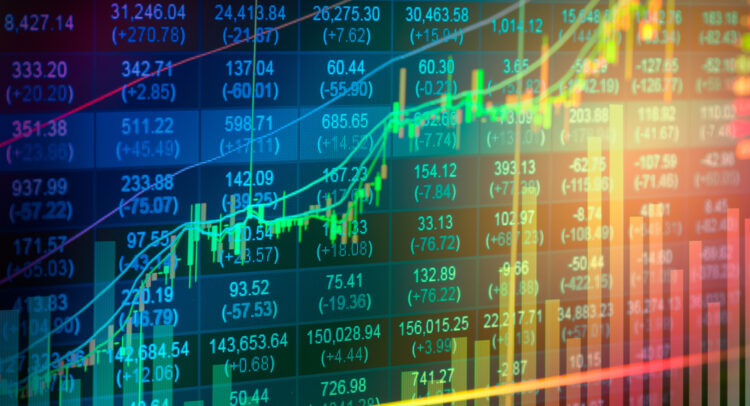Last Updated 4:05 PM EST
Maximize Your Portfolio with Data Driven Insights:
- Leverage the power of TipRanks' Smart Score, a data-driven tool to help you uncover top performing stocks and make informed investment decisions.
- Monitor your stock picks and compare them to top Wall Street Analysts' recommendations with Your Smart Portfolio
Stock indices finished today’s trading session in the green. Indeed, the Nasdaq 100 (NDX), the S&P 500 (SPX) and the Dow Jones Industrial Average (DJIA) gained 0.14%, 0.14%, and 0.22%, respectively. Nevertheless, indices ended lower on the week.
The real estate sector (XLRE) was the session’s laggard, as it lost 0.62%. Conversely, the energy sector (XLE) was the session’s leader, with a gain of 1%.
Furthermore, the U.S. 10-Year Treasury yield increased to 4.26%, an increase of one basis point. Similarly, the Two-Year Treasury yield also increased, as it hovers around 4.99%.
The Atlanta Federal Reserve updated its latest GDPNow reading, which allows it to estimate GDP growth in real time. The “nowcast” becomes more accurate as more economic data is released throughout the quarter. Currently, it estimates that the economy will expand by about 5.6% in the third quarter.
This is unchanged compared to the previous estimate, which can be attributed to this morning’s wholesale trade report from the U.S. Census Bureau.
Last Updated 1:00 PM EST
Stocks are in the green so far in today’s trading session. Earlier today, Goldman Sachs expressed increased optimism about the U.S. economy’s outlook, notably decreasing its recession probability estimation for the next year from 35% in March to 15%, citing encouraging signs in inflation and the labor market. This contrasted starkly with the prevalent consensus among Bloomberg economists, who hold a 60% recession probability.
Goldman Sachs anticipates a potential economic deceleration in the last quarter of this year due to factors like the resumption of student loan payments and a dip in the housing market, but they foresee a quick recovery spurred by strong job growth and increased real disposable income in 2024.
On the flip side, financial firm Roth MKM warned that it might be premature to discard the possibility of a recession just yet. According to them, the ongoing inversion of the yield curve, a phenomenon that has historically preceded recessions, cannot be overlooked.
Indeed, market rallies are common after an inversion, and a recession may still be looming. Furthermore, we are currently 13 months into the inversion, close to the historical average lag of 14 months preceding a recession. As both firms highlight different indicators and adopt varying outlooks, it underscores the complex and multifaceted nature of predicting economic trends.
Last updated: 9:30AM EST
Stocks opened higher on Friday, with the Nasdaq 100 (NDX) up by 0.5%, while the S&P 500 (SPX) and the Dow Jones Industrial Average (DJIA) advanced by 0.25% and 0.03%, respectively, at 9:30 a.m. EST, September 8.
First published: 2:19AM EST
U.S. Futures are trending mixed on Friday morning following the mixed closing of major averages yesterday. Futures on the Nasdaq 100 (NDX) are up by 0.07%, while those on the S&P 500 (SPX) and the Dow Jones Industrial Average (DJIA) are down by 0.03% and 0.05%, respectively, at 4:30 a.m. EST, September 8.
The three major indices, namely the SPX, the Nasdaq Composite, and the DJIA are on track to finish the current trading week on a negative footing. Apple (AAPL) lost 2.9% yesterday on news that China is banning iPhone use by government employees, dragging down other tech stocks too.
August was a rather sluggish month for stocks, and September continues to be hard on the stock market as well. A CNBC report citing State Street Global Advisors noted that investors fled stocks and bought $11 billion worth of bonds via exchange-traded funds (ETFs) in August.
Notably, the initial jobless claims fell by 13,000 to 216,000 in the week ending September 2 – their lowest level since mid-February. The fresh economic data sets have confounded economists’ expectations of the Fed’s next interest rate decision.
Meanwhile, supermarket chain operator Kroger (KR) is set to release its Q2FY23 results today before the market opens. With a solid history of outperforming expectations, analysts expect this quarter to be no different. Shares of digital contract company DocuSign (DOCU) jumped in after-hours trading yesterday following a Q2 report that surpassed the market’s expectations.
Conversely, shares of home furnishing retailer RH (RH) fell 7.8% in extended trade yesterday on the issue of soft sales guidance. Surprisingly, RH did manage to outpace the consensus on both the top and bottom lines for Q2FY23.
Elsewhere, European indices are trading in the red this morning, continuing their seven-day losing streak. The final data on the euro zone’s second-quarter GDP showed a modest 0.1% increase. Traders are being watchful as global investor sentiment takes a toll from the mixed economic data sets.
Asia-Pacific Markets End Lower on Friday
Asia-Pacific indices finished in the red on Friday. Japan’s revised second-quarter GDP estimates came in lower than expected, dragging down Japanese stocks. Japan recorded a 4.8% quarter-over-quarter annualized growth in Q2, lower than the 6% reported in the preliminary estimates.
Following the news, Japan’s Nikkei and Topix indices ended down by 1.16% and 1.02%, respectively.
Hong Kong markets remained closed for trading today due to a black rainstorm warning. In the meantime, China’s Shanghai Composite and Shenzhen Component indices ended lower by 0.18% and 0.38%, respectively.
Interested in more economic insights? Tune in to our LIVE webinar.









